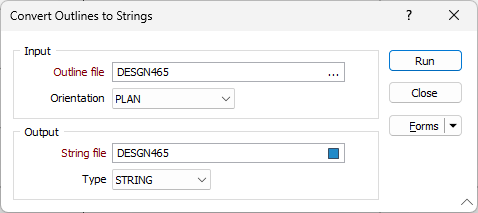Convert Outlines to Strings
![]()
Input
File
Double-click (F3) or click the ellipsis to the right of the File box, to specify the name of one or more Outline file. To select multiple files, hold down the CTRL key or the SHIFT key as you select them with the mouse.
Orientation
Specify the 3D orientation of the data in the Outline file (i.e. PLAN, LOOKING WEST or LOOKING NORTH).
The specified orientation will determine how the coordinates are written to the output file and allows two-dimensional data to be displayed in cross section or long section. This is especially useful if, for example, you are converting geological sections that were produced in a 2D GIS package.
Output
File
Specify an output file Type and then double-click (F3), to specify the name of the output (typically String) file.
When you create a new String file, the structure of the file can be controlled by the VIZEX-STRINGS-TEMPLATE.STR file located in your Environment folder:
%AllUsersProfile%\Micromine\Micromine\Environment
This TEMPLATE file allows the TYPE, WIDTH and DECIMALS of the fields in the file to be defined.
While the field order is hard-coded (E, N, Z, STRING, JOIN) the field names are taken from the settings on the Defaults tab of the Options | System | Form Set Options form.
Any additional fields in the TEMPLATE file are honoured in terms of name and structure.

Forms
Click the Forms button to select and open a saved form set, or if a form set has been loaded, save the current form set
Run
When you have specified one or more Outline file, and specified an output file, click Run to begin the conversion process.